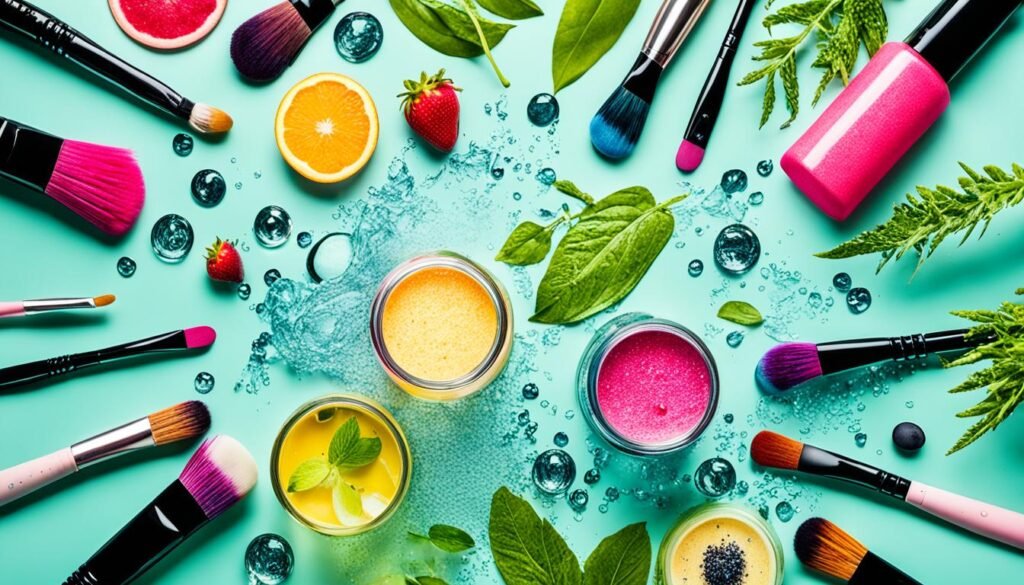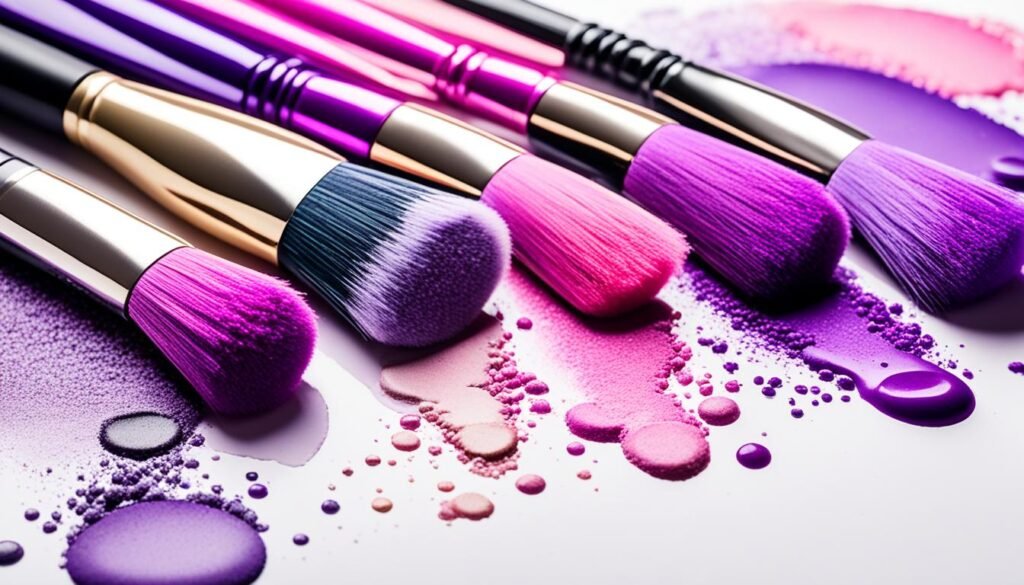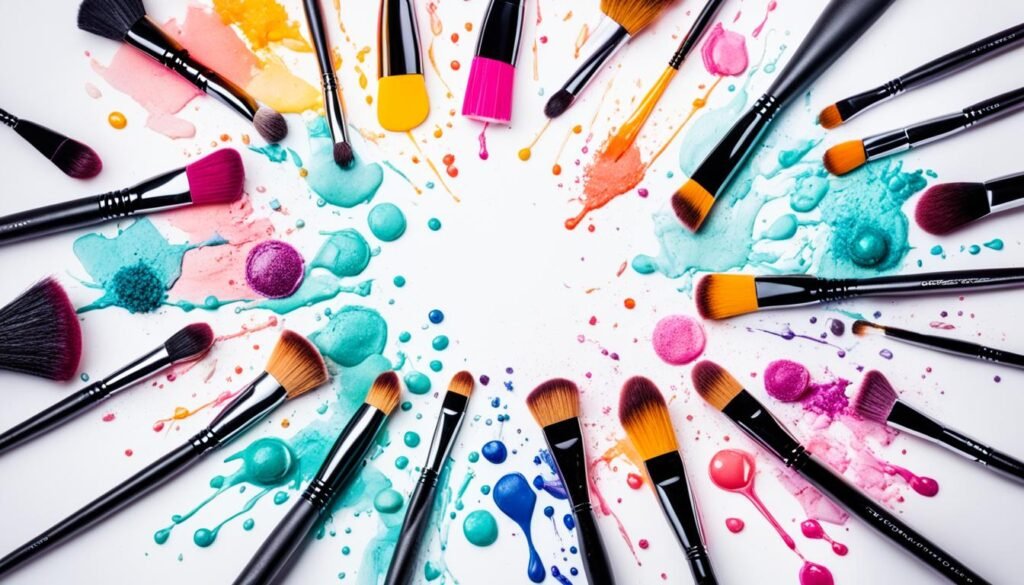Are you confident that your makeup brushes are squeaky clean? Think again. Cleaning your makeup brushes goes beyond just a surface cleanse – it’s about maintaining hygiene, enhancing application, and extending their lifespan. But what is the best way to clean your makeup brushes? And are there any professional tips and secrets that you may not be aware of?
In this comprehensive guide, we will unravel the mysteries of makeup brush cleaning. From the top brush cleaning methods to the best brush cleansers on the market, we will provide you with the knowledge and insights needed to keep your brushes pristine and performing at their best.
Key Takeaways:
- Regular cleaning of makeup brushes is crucial for maintaining hygiene and ensuring optimal application.
- Weekly washing is recommended to prevent product buildup and acne breakouts.
- Choosing the right cleansing products is essential to avoid damaging the brushes.
- The process of cleaning makeup brushes involves wetting, cleansing, rinsing, disinfecting, and drying.
- Alternative cleaning methods, such as using alcohol or dish soap, can be effective.
The Benefits of Regular Makeup Brush Cleaning
Regular cleaning of makeup brushes offers several benefits. It ensures brush hygiene by eliminating bacteria and germs that can cause skin issues. Clean brushes also maintain their performance and quality, allowing for flawless and precise makeup application. Proper brush maintenance, including regular cleaning, is crucial for extending the longevity of the brushes. By keeping your brushes clean, you can enhance their lifespan and avoid the need for frequent replacements.
Brush Hygiene: Protecting Your Skin
Your makeup brushes come into direct contact with your skin, and without regular cleaning, they can accumulate dirt, oil, and bacteria. This buildup can lead to clogged pores, breakouts, and other skin issues. By regularly cleaning your brushes, you can ensure brush hygiene and minimize the risk of skin problems caused by bacteria on dirty brushes.
Optimal Performance for Flawless Application
Clean brushes are essential for achieving flawless and precise makeup application. When brushes are caked with old product residue, it can affect the color payoff and hinder the blending ability. By cleaning your brushes regularly, you can maintain their performance and ensure that your makeup goes on smoothly for a professional-looking finish.
Extend Your Brushes’ Lifespan
Quality makeup brushes can be quite an investment, and proper care can help extend their longevity. Regular cleaning removes product buildup, which can cause bristles to become stiff and brittle over time. By keeping your brushes clean, you can preserve their softness and flexibility, allowing them to last for years without needing frequent replacements.
Cleaning your makeup brushes is a simple yet effective way to maintain brush hygiene, optimize their performance, and extend their lifespan. In the next section, we’ll explore how often you should clean your brushes to keep them in top shape.
How Often Should You Clean Your Makeup Brushes?
When it comes to makeup brush cleaning, establishing a regular routine is essential to maintain optimal application and prevent bacterial buildup. Makeup artists strongly recommend washing your brushes at least once a week to ensure clean and hygienic brushes.
If you regularly change your colors or use different products, it may be necessary to clean your brushes more frequently. This helps to prevent product buildup, which can affect the performance and color payoff of your brushes.
Pro Tip: Cleaning your brushes on a regular basis not only enhances their performance but also minimizes the risk of acne breakouts caused by bacteria on dirty brushes.
By incorporating a weekly brush cleaning routine into your skincare and beauty regimen, you can be confident that your brushes are always ready for flawless makeup application.
The Benefits of Regular Brush Cleaning
- Maintains optimal makeup application
- Prevents bacterial buildup
- Enhances color payoff
- Minimizes the risk of acne breakouts
| Frequency of Brush Cleaning | Benefits |
|---|---|
| At least once a week | – Keeps brushes clean and hygienic – Prevents bacterial growth – Maintains optimal performance |
| More frequently if changing colors or products | – Avoids color contamination – Provides truer color payoff – Minimizes risk of skin irritations |
Regularly cleaning your makeup brushes not only ensures the longevity of your brushes but also helps maintain their performance and quality. With a clean set of brushes, you can achieve flawless and professional-looking makeup application every time.
Choosing the Right Cleansing Products for Makeup Brushes
Using the right products for cleaning your brushes is essential to ensure effective and safe cleansing. Makeup artists recommend avoiding cleansers with high alcohol content or harsh solvents, as they can damage the brushes over time. There are various dedicated brush cleansers available in the market, such as the Parian Spirit Professional Makeup Brush Cleaner, which gently dissolves different types of makeup products. Gentle soap, like Johnson’s Head to Toe baby wash or dish soap, mixed with water can also be effective in cleaning brushes. It is crucial to choose cleansers that are suitable for the brush materials and do not leave any residue on the bristles.
When it comes to makeup brush cleaning products, you have several options to choose from. Here are some popular brush cleansers and gentle soaps recommended by beauty enthusiasts:
| Product | Description |
|---|---|
| Parian Spirit Professional Makeup Brush Cleaner | A dedicated brush cleaner that effectively dissolves makeup products while keeping the bristles soft and intact. |
| Johnson’s Head to Toe baby wash | A gentle soap that is suitable for cleaning brushes without causing any damage or residue. |
| Dish soap | Regular dish soap mixed with water can be an affordable and effective option for cleaning brushes. |
Remember to choose a cleanser that is specifically formulated for makeup brushes and is gentle on the bristles. It’s important to use products that won’t strip away the natural oils or compromise the integrity of the brush.
Now that you know the importance of choosing the right cleansing products, let’s move on to the process of cleaning your makeup brushes.
The Process of Cleaning Makeup Brushes
Cleaning your makeup brushes is a simple yet essential step in maintaining their performance and hygiene. Follow this easy-to-follow process to ensure your brushes are clean, disinfected, and ready for flawless makeup application.
- Begin by wetting the bristles of your brush with water. Avoid wetting the handle, as this can loosen the adhesive holding the bristles in place.
- Apply a gentle cleanser or soap to the wet bristles. You can use specialized brush cleansers or even mild shampoos or baby wash.
- Gently swirl the brush in your palm or on a cleaning mat to loosen and remove any product buildup. Pay extra attention to the center of the brush where residue tends to accumulate.
- Rinse the brushes thoroughly under running water to remove any soap or cleanser residue. This step is crucial to ensure your brushes are free from any potential irritants that could transfer to your skin.
- To disinfect your brushes, you can use isopropyl alcohol. Dampen a cotton pad with the alcohol and gently swipe it over the bristles. This step helps eliminate bacteria and germs that may have accumulated on your brushes.
- After cleaning, gently pat the brushes dry with a clean towel or paper towel. Avoid rubbing the bristles vigorously, as this can damage the brush fibers.
- If necessary, reshape the bristles to their original form. Use your fingers to reshape the bristles or gently comb them with a clean brush comb or your fingers.
- Finally, allow the brushes to air dry completely before storing or using them again. Place them on a clean towel or a brush drying rack, ensuring they are fully dry to prevent any mold or bacterial growth.
By following this simple cleaning process, you can maintain the cleanliness, performance, and longevity of your makeup brushes. Remember to clean your brushes regularly to avoid product buildup and bacterial growth, ensuring that your brushes deliver flawless makeup application every time.
| Step | Action |
|---|---|
| 1 | Wet the bristles with water. |
| 2 | Apply a gentle cleanser or soap. |
| 3 | Gently swirl the brush in your palm or on a cleaning mat to remove product buildup. |
| 4 | Rinse the brushes thoroughly to remove any soap residue. |
| 5 | Disinfect the brushes using isopropyl alcohol. |
| 6 | Pat dry the brushes with a clean towel or paper towel. |
| 7 | Reshape the bristles if necessary. |
| 8 | Allow the brushes to air dry completely before storing or using them again. |
Alternative Cleaning Methods for Makeup Brushes
In addition to the traditional brush cleaning methods discussed earlier, there are alternative approaches that can be just as effective in keeping your brushes clean and sanitary. These methods offer a convenient way to maintain the hygiene of your makeup brushes without compromising their quality and performance.
Using Isopropyl Alcohol
One popular technique among makeup artists is using isopropyl alcohol to clean their brushes. Simply dampen a tissue or cotton pad with isopropyl alcohol and gently sweep it over the bristles of your brush, removing any residual makeup and disinfecting the brush effectively. This method is particularly helpful when you need to switch between different shades or products quickly.
Gentle Cleansing with Dish Soap or Baby Wash
Another alternative method is using gentle cleansers like dish soap or baby wash mixed with water. Create a solution by adding a small amount of cleanser to a bowl of warm water. Gently swirl the brush in the solution, allowing the soapy water to penetrate the bristles and break down any makeup residue. Rinse the brush thoroughly under running water, ensuring all the soap is washed away, and gently squeeze out any excess water.
Quick Clean with Brush Sprays
For those times when you need to clean your brushes quickly between uses, brush sprays can be a convenient option. Products like Sephora’s daily brush spray are designed to provide a quick cleanse to remove surface makeup and bacteria. Simply spray the brush spray onto a tissue or paper towel, swipe the brush back and forth to loosen any product residue, and allow it to air dry.
Experimenting with different cleaning methods can help you find what works best for you and your brushes. Whether you opt for isopropyl alcohol, gentle cleansers, or brush sprays, these alternatives offer efficient ways to keep your brushes clean and ready for flawless makeup application.

Tips for Maintaining Clean Brushes
Alongside regular Makeup Brush Cleaning, proper maintenance of your makeup brushes is essential to ensure their cleanliness and longevity. Here are some vital brush maintenance tips to keep your brushes in top condition:
1. Proper Brush Storage
After cleaning your brushes, it’s important to store them in a clean and dry space to prevent dust accumulation. Use a brush holder or brush roll to keep your brushes organized and protected from dirt or damage.
2. Brush Drying Techniques
Allow your brushes to air dry completely before using or storing them. Placing wet brushes in a closed container can create a breeding ground for mold or bacterial growth. To speed up the drying process, place your brushes on a clean towel or use a brush drying stand.
3. Brush Replacement
Regularly check your brushes for signs of wear and tear. If you notice excessive shedding or bristles that are no longer intact, it’s time to replace them. Using brushes that are in good condition ensures optimal performance and prevents any issues during makeup application.
By following these simple brush maintenance tips, you can enjoy clean and high-performing brushes that enhance your makeup application.
Comparing Brush Maintenance Methods
| Methods | Pros | Cons |
|---|---|---|
| Using a brush cleanser | – Provides effective cleaning – Suitable for various brush types |
– Some cleansers may contain chemicals – Additional cost |
| Using gentle soap and water | – Affordable and readily available – Suitable for most brushes |
– Requires thorough rinsing – May require more drying time |
| Using brush sprays | – Quick and convenient cleaning option – Suitable for spot cleaning |
– Not as thorough as other methods – Can leave residue on bristles |
Remember to choose a cleaning method that suits your preferences and brush types, and always prioritize the cleanliness and maintenance of your makeup brushes.
Expert Recommendations for Makeup Brush Cleaning
Keeping your makeup brushes clean is essential for maintaining their performance and promoting good hygiene. To help you achieve optimal results, makeup experts and artists share their valuable tips and recommendations for makeup brush cleaning.
When it comes to trusted brush cleansers, there are several options that professionals recommend. The Oribe Signature Shampoo is a favorite among makeup artists for its gentle yet effective cleansing properties. Another popular choice is the Parian Spirit Professional Makeup Brush Cleaner, known for its ability to dissolve various types of makeup products without damaging the brushes. If you prefer using a gentle soap, experts often recommend Johnson’s Head to Toe baby wash for its mild formula that effectively cleanses brushes without leaving any residue.
To ensure proper brush cleaning, experts emphasize the importance of following a thorough cleaning routine. Start by wetting the bristles with water, then apply the cleanser or soap. Gently swirl the brush in your palm or use a cleaning mat to remove any makeup residue and product buildup. Rinse the brushes thoroughly to eliminate any soap residue, and consider using isopropyl alcohol for disinfecting purposes.
After cleaning, it is crucial to allow the brushes to dry completely before using or storing them. Gently pat the brushes dry with a clean towel or paper towel, reshape the bristles if necessary, and let them air dry in a well-ventilated area. This helps prevent mold or bacterial growth on the brushes.
Experts also stress the importance of regular cleaning and maintenance to ensure the longevity of your brushes. By following their advice and using trusted cleansers, you can keep your brushes clean, hygienic, and performing at their best.
Incorporating expert cleaning tips and utilizing professional brush cleansers can make a significant difference in the cleanliness and performance of your makeup brushes. Remember to establish a regular cleaning routine, choose the right cleansers for your brushes, and allow them to dry properly before use or storage. By following expert recommendations, you can maintain clean and hygienic brushes for flawless makeup application.
The Impact of Clean Brushes on Makeup Application
Clean makeup brushes play a significant role in achieving flawless makeup application. When your brushes are free of product buildup and bacteria, they provide truer color payoff and allow for seamless blending. On the other hand, using dirty brushes can lead to spotty application and make it difficult to achieve your desired makeup looks. Keeping your brushes clean is not only essential for optimal performance but also for maintaining brush hygiene and preventing skin issues caused by bacterial growth.
Regularly cleaning your makeup brushes ensures that they are free from dirt, dust, oils, and old product residue. This not only improves the cleanliness of your brushes but also enhances the performance of your makeup. Clean brushes pick up and distribute products more evenly, allowing for smoother and more precise application.
Furthermore, clean brushes provide truer color payoff. When makeup products mix with old residue on dirty brushes, the colors can become muddled, resulting in less vibrant and less accurate color application. To achieve the truest color payoff and make the most of your makeup products, it’s crucial to clean your brushes regularly.
Another important aspect of brush cleanliness is preventing skin issues. Dirty brushes can harbor bacteria, which can lead to acne breakouts, irritations, and other skin problems. By regularly cleaning your brushes, you minimize the risk of transferring bacteria onto your skin, ensuring a healthier complexion.
| Benefits of Clean Brushes | Consequences of Dirty Brushes |
|---|---|
| Truer color payoff | Muddled and less vibrant color application |
| Seamless blending | Spotty application and difficulty in achieving desired looks |
| Improved makeup performance | Uneven product distribution |
| Prevention of skin issues | Risk of bacterial growth leading to acne breakouts and irritations |
Brush Cleaning Tips from the Makeup Community
When it comes to cleaning makeup brushes, the makeup community has no shortage of tips and tricks to share. From alternative cleaning methods to personal experiences, there’s a wealth of knowledge to tap into. So, let’s dive into some of the community’s top brush cleaning recommendations!
1. Dish Soap or Baby Wash
Many makeup enthusiasts swear by using dish soap or gentle baby wash to clean their brushes. These household products effectively remove makeup residue and oils without damaging the bristles. Simply mix a small amount with water, lather up your brushes, and rinse thoroughly. This method is cost-effective and easily accessible, making it a favorite among budget-conscious beauty lovers.
2. Alcohol for Quick Cleaning
When in need of a quick clean between uses, some community members turn to isopropyl alcohol. Dabbing a tissue with alcohol and gently wiping the bristles helps remove product buildup and disinfect the brushes. This technique is especially handy for those who frequently switch between different colors or want to maintain brush hygiene on-the-go.
3. Specific Brush Cleansers
Not everyone is a fan of DIY cleaning methods. If you prefer dedicated brush cleansers, there are plenty of options available. Brands like mineraltones.com offer brush cleansers formulated specifically for effective and safe cleaning. These cleansers are designed to dissolve stubborn makeup products while keeping the brushes in optimal condition. They can be a convenient choice for those who prefer ready-to-use products.
4. Regular Cleaning Routine
The makeup community strongly emphasizes the importance of incorporating regular brush cleaning into your makeup routine. Cleaning your brushes after each use helps maintain their performance and prevents bacterial buildup. By making it a habit, you’ll ensure that your brushes are always ready for flawless makeup application.
“Regular brush cleaning is a game-changer. It not only keeps my brushes in top shape but also helps me achieve better color payoff and smoother application.” – @BeautyGuru123
5. Washing with Shampoo or Soap
Using a gentle shampoo or soap is another popular method for cleaning makeup brushes. These products effectively remove product residue while being mild enough for the bristles. Take a pea-sized amount of shampoo or soap, lather it up with water, and gently work it into the bristles. Rinse thoroughly until the water runs clear, and let the brushes air dry completely.
Remember, brush cleaning experiences may vary, so it’s important to find a method that works best for you. Whether you prefer homemade solutions or specific brush cleansers, the key is to prioritize regular cleaning to maintain brush hygiene and prolong their lifespan.

| Method | Pros | Cons |
|---|---|---|
| Dish Soap or Baby Wash | Cost-effective, easily accessible | May require extra rinsing to remove all soap |
| Alcohol for Quick Cleaning | Convenient for quick cleanups | Can be drying on brushes with natural hair |
| Specific Brush Cleansers | Formulated for effective cleaning | Can be more expensive |
| Regular Cleaning Routine | Maintains brush performance | Requires time and consistency |
| Washing with Shampoo or Soap | Gentle on brushes, removes residue | May take longer for brushes to dry |
Table: Comparison of different brush cleaning methods.
Tips for Cleaning Different Types of Makeup Brushes
Different types of makeup brushes may require slightly different cleaning approaches. It’s important to understand the materials your brushes are made from to ensure their proper maintenance and longevity.
If you have synthetic brushes, you’re in luck! Synthetic brushes are generally easier to clean and can withstand regular washing with gentle cleansers. A mild soap or a dedicated brush cleanser like the Mineraltones Brush Cleanser will effectively remove makeup residue from synthetic bristles and leave them clean and ready for use.
On the other hand, natural hair brushes require some extra care. These brushes tend to be more delicate and should be treated with gentle oils after cleaning to keep the bristles soft and prevent them from drying out. You can use a small amount of olive oil or a specific brush conditioning oil, like the Mineraltones Brush Conditioning Oil, to nourish and protect your natural hair brushes.
Specialty brushes, such as fan brushes or stippling brushes, may have their own specific cleaning requirements. For example, fan brushes can be gently swept on a tissue with isopropyl alcohol to remove excess product without fully immersing them in water. Refer to the manufacturer’s recommendations or seek advice from professionals to ensure you’re cleaning your specialty brushes correctly.
Remember, clean brushes not only promote better makeup application but also help maintain the overall hygiene of your beauty routine. By following these tips and using the right cleaning products, you can keep your brushes in excellent condition and enjoy flawless makeup application every time.
| Brush Type | Cleaning Method |
|---|---|
| Synthetic Brushes | Wash with a gentle cleanser or brush cleanser |
| Natural Hair Brushes | Wash with a mild soap, condition with oil after cleaning |
| Specialty Brushes | Refer to manufacturer’s recommendations or seek professional advice |
Maintaining Hygiene and Extending Brush Life
Proper cleaning and maintenance of makeup brushes are crucial for maintaining brush hygiene and extending their lifespan. By incorporating regular cleaning into your beauty routine, you can ensure that your brushes remain free from bacteria, dust, and dirt. It is recommended to wash your brushes at least once a week to prevent product buildup and maintain their cleanliness.
Follow the recommended cleaning methods, such as using suitable brush cleansers or gentle soaps, to maintain the performance and quality of your brushes. Avoid cleansers with high alcohol content or harsh solvents, as they can cause damage over time. Look for trusted brush cleansers like the Parian Spirit Professional Makeup Brush Cleaner or use gentle soaps like Johnson’s Head to Toe baby wash or dish soap mixed with water.
With proper care, your brushes can last for years, providing you with flawless makeup application. Ensure that you store your cleaned brushes in a clean and dry space to prevent dust accumulation. Let them air dry completely before storing or using them again to avoid mold or bacterial growth. If you notice excessive shedding or damaged bristles, consider replacing your brushes to maintain optimal performance and hygiene.
Makeup Brush Cleaning, brush hygiene practices, and brush care for longevity are crucial aspects of maintaining clean brushes and improving your overall makeup application. By following these practices, you can enjoy the benefits of clean brushes while ensuring their longevity.

